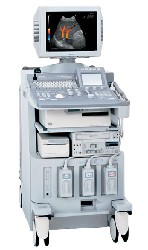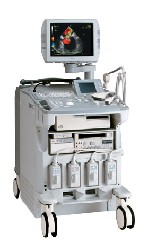Medical Ultrasound Imaging
Friday, 3 May 2024
'Distortion' Searchterm 'Distortion' found in 4 articles 4 definitions [ • ] Result Pages : •
The propagation of high amplitude ultrasound waves is inadequate described by a linear wave equation. Non-linear propagation is to expect if the power levels are high enough to make non-linear effects significant.
A non-linear propagation results in the distortion of the transmitted waveforms, resulting in the generation of harmonics of the initial frequency components transmitted by the transducer. In the near field of ultrasound probes, the occurring diffraction and focusing effects make this process complex. The distortion of a wavefront propagating in a medium in which the compressional phase moves slightly faster than the rarefactional phase, results is the conversion of some wave energy into higher harmonics of the fundamental frequency. The effect increases strongly with increasing wave amplitude. Further Reading: News & More:
•  From ALOKA Co., Ltd.;
From ALOKA Co., Ltd.;'A Platform for Pure Harmonic Detection The SSD-5000 is the second platform in our ProSound™ line of superior ultrasound systems. The Pure Harmonic Detection technology provides distortion-free fundamental frequency transmission, offering optimum Harmonic Echo™ image quality. This technology is especially effective for obese patients and in a variety of technically difficult scanning conditions.' •  From ALOKA Co., Ltd.;
From ALOKA Co., Ltd.;'A Platform for Pure Harmonic Detection Harmonic Echo™ technology constructs images using second harmonic components, which contain far less artifacts and noise than fundamental-frequency components. Pure Harmonic Detection is a technology to transmit distortion-free, fundamental-frequency ultrasound beams. And when the fundamental-frequency ultrasound beam is a pure sinusoidal wave, both the fundamental-frequency image and the Harmonic Echo™ image are much clearer with less noise. This technology is especially effective for obese patients and in a variety technically difficult scanning conditions.' •
Different sound velocities in tissue are causing refraction artifacts. With convex elastomer lens transducers, sound beam refraction at the skin interface can alter the transducer's focusing characteristics and beam profile, cause element to element nonuniformity, and cause phase changes in the acoustic wave. These cumulative refraction induced errors degrade the image quality through distortion and loss of resolution. Because the amount of refraction is proportional to the velocity mismatch, the greater the mismatch, the greater the refraction.
Result Pages : |
Medical-Ultrasound-Imaging.com
former US-TIP.com
Member of SoftWays' Medical Imaging Group - MR-TIP • Radiology TIP • Medical-Ultrasound-Imaging
Copyright © 2008 - 2024 SoftWays. All rights reserved.
Terms of Use | Privacy Policy | Advertise With Us
former US-TIP.com
Member of SoftWays' Medical Imaging Group - MR-TIP • Radiology TIP • Medical-Ultrasound-Imaging
Copyright © 2008 - 2024 SoftWays. All rights reserved.
Terms of Use | Privacy Policy | Advertise With Us
[last update: 2023-11-06 01:42:00]




